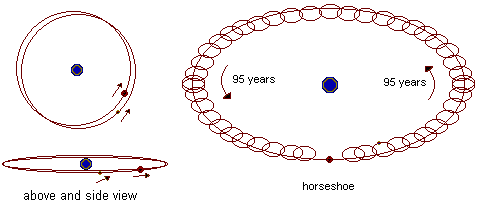
In January 2002, an object which may be qualified co-orbital with the Earth and which has a period of quasi-Earth-satellite state has been discovered. The asteroid 2002 AA29 is 200 ft wide. The co-orbital orbit of this object works this way (you assume that this orbit is almost the same than the one of the Earth and that, from its inclination relative to the ecliptic, it brings the asteroid above, and then under, the Earth's orbit plane): the asteroid, in one year, follows a kind of spiral around the line of orbit of the Earth; during 95 it is catching the Earth, but, then it apparently moves back, during again 95 years and, this, time, on the base of the two relative speeds, it is the asteroid which is catched by the Earth. It is this cycle which makes the so-called "horseshoe" orbit. As far the asteroid being a quasi-satellite for a while, the part of the orbit which is not occupied by the asteroid during its 95-95 years of horseshoe orbit, is occupied by it (and in the same spiral way at very distant intervals, during about 50 years; the asteroid is indeed trapped in the inter-horseshoe zone. The last quasi-satellite period took place about 550 AD and the next one will occur about 2600 AD. Then the horseshoe orbit starts again -95 years to catch the Earth, 95 years of relative apparent retrograde motion. The greatest nearing like the one of January, 8th, takes place at either end of the 95 years cycle, when the asteroid is at its nearest of the Earth, at each side of the "quasi-satellite" zone.

Other co-orbital objects, like Cruithne, had been discovered previously. But they do not have any quasi-satellite period. They never roam in the inter-horseshoe space. 2002 AA29 was the first found to have this quasi-satellite period. 2016 HO3 is also a quasi-satellite to Earth as it loops around but never ventures very far away as both go around the Sun. Calculations indicate 2016 HO3 has been a stable quasi-satellite of Earth for almost a century, and it will continue to follow this pattern as Earth's companion for centuries to come. 2016 HO3 spends about half of the time closer to the Sun than Earth and passes ahead of our planet, and about half of the time farther away, causing it to fall behind. Its orbit is also tilted a little making the asteroid move up and down relative to Earth's orbital plane; it also, at last undergoes a slow, back-and-forth twist limited by Earth's gravity limiting the move to 38 to 100 times the distance of our Moon. The size of this object has not yet been firmly established, but it is likely larger than 120 feet (40 meters) and smaller than 300 feet (100 meters). Asteroid 2016 HO3 was first spotted by April 2016, by the Pan-STARRS 1 survey. 2003 YN107 followed a similar orbital pattern for a while over 10 years ago, but it has since departed our vicinity
Such objects, generally, are ECAs, an "Earth coorbital asteroids". The base for the asteroid staying near the Earth's orbit is the fact that it is in a 1:1 resonance motion with the Earth (it runs around the Sun in the same amount of time than the Earth does). Other ECAs were already known, of them Cruithne. 2002 AA29 is peculiar as it has this period of quasi-satellite state
Another type of objects being in a 1:1 resonance motion with their planet are objects which, around Jupiter and Saturn, are anchored at two Lagrange points, on each side of the planet (such are the Trojan asteroids for Jupiter). It is not impossible that quasi-satellites exist for remote planets of the solar system (as far Uranus and Neptune are concerned, these objets would have sufficiently steady orbits to have been linkened to the planets since the origins of the solar system; as far Jupiter and Saturn are concerned, the orbit of the quasi-satellites would be more unstable and these two planets would only have transient quasi-satellites). Jovian Trojans began to be discovered by German astronomer Max Wolf who spotted the leading-ahead, 81-mile (130-km) wide Achilles on Feb. 22, 1906. The name Trojans comes after the history in which Greek soldiers hid inside in a giant horse statue to launch a surprise attack on the Trojan people of the city of Troy as leading Trojans were named after the Greek heroes and trailing ones the heroes of Troy (albeit Hector is found in the Greek, and Patroclus in the Trojan camps respectively). Both the leading and trailing packs of Jupiter's Trojans are made up of predominantly dark, reddish rocks with a matte, non-reflecting surface as the leading pack of Trojans outnumbers the trailing one by 40 percent. There are six planets in our solar system with known Trojan asteroidsóJupiter: Neptune, Mars, Venus, Uranus and even Earth (2010 TK7 found by 2010 as more likely exist but difficult to detect as always lost in Sun's glare). More than 6,000 Trojans are co-orbiting with Jupiter. 1,750 Trojans have been catalogued by the NEOWISE project lately as they are much more numerous indeed with as many objects in these two swarms as there are in the entirety of the Asteroid Belt. Jovian Trojans do not resemble the asteroids from the main belt, nor the Kuiper belt family of objects as they likely originally were asteroids which were captured locally. Late studies have shown that Trojans mostly belong to the D-type asteroids mostly, with some C and P-types which are more grey-bluish in color. On the other hand, one does not know if Earth has Trojans
Website Manager: G. Guichard, site 'Amateur Astronomy,' http://stars5.6te.net. Page Editor: G. Guichard. last edited: 6/17/2016. contact us at ggwebsites@outlook.com